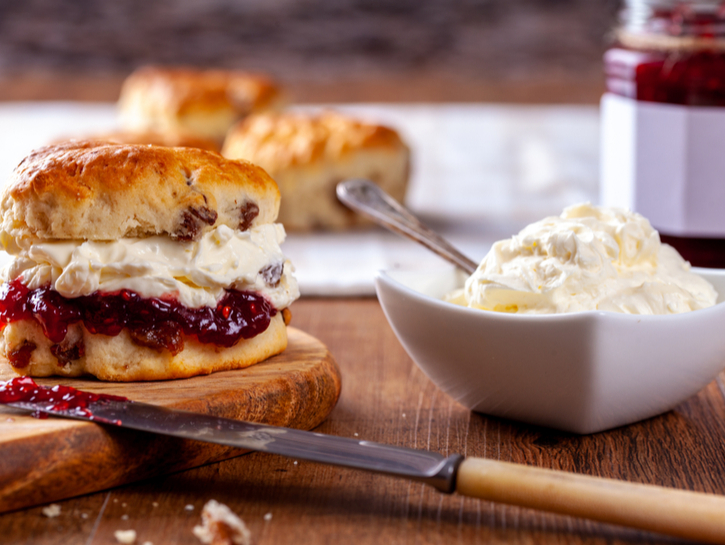While whipped cream, butter and cream cheese all come to mind as a topping for biscuits, scones or other pastries, there is another condiment that is essential in England and other parts of the world: clotted cream. This sweet, thick and creamy mixture adds an incredible flavor and a smooth texture to your favorite pastries — but what exactly is clotted cream, and why should you be using it?
What Is Clotted Cream?

Magdanatka/Shutterstock
The name “clotted cream” might not make this mixture sound particularly appetizing, but it is a delicious and flavorful addition to any toast or biscuit. Clotted cream is a thick, creamy mixture made by heating milk on a stove top for several hours until the cream rises to the top. The cream is then skimmed from the top of the hot milk and has the consistency of cream cheese, the color of yellow butter and the sweet taste of cream. When prepared traditionally, the cream forms a slight, golden crust. Clotted cream originated in Devon and Cornwall in England, and the incredibly sweet condiment is widely popular throughout the U.K., where it is commonly served with pastries during afternoon tea.. Its high-fat content makes it particularly rich and appealing, and you’ll find yourself craving the smooth cream long after you’ve finished eating it.
Make Your Own Clotted Cream

Robyn Mackenzie/Shutterstock
If you live in the U.S., it’s difficult to find this sweet English condiment. Luckily, making your own clotted cream is a simple process that you can do a few different ways.
Traditional Clotted Cream
This method mimics the traditional clotted cream recipe, where whipping cream is poured into a casserole dish and heated until a skin develops on the surface. Simply scrape this cream off the liquid, refrigerate and stir before serving. Make sure to plan ahead when preparing clotted cream this way — it takes about three days before it is ready to serve.
Clotted Cream Substitute
If you don’t want to invest in a multi-day commitment for your cream, you can make a clotted cream substitute that’s ready in only 10 minutes. Instead of heating up whipping cream, simply combine heavy cream, sour cream and confectioners sugar until the ingredients are combined into a smooth mixture.
How Do You Use Clotted Cream?

Lily Trott/Shutterstock
In England, clotted cream is a staple of tea time snacks and often served as a spread on scones, biscuits or muffins. The sweet cream boosts the flavor of baked goods and provides a delicious creaminess to flaky and dry pastries. The cream is often layered with other tasty spreads, such as jam, jelly or butter. The whipped texture and sweet flavor of clotted cream also make it optimal for desserts, such as clotted cream fudge, rice pudding, sponge cake, truffles and ice cream.
